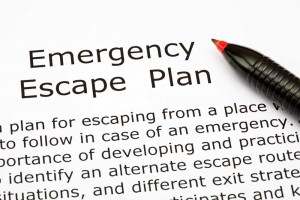Have you ever considered the fact that you could have a fire in your chimney? What would you and your family due if this were to happen? Do you have an escape plan? Is there a place outside to meet and ensure that everyone has gotten out safely? Who is going to help grandma get out of the house? Here are a few tips to help you organize your escape plan.

- The first step is in creating a complete floor plan of the home. It should include every doorway and window in every room. In addition, you will want to make note of all windows that have something offering support just outside the window, such as a garage or rooftop, that will offer safe exit. These windows may be considered secondary exits for not only the room occupant, but other family members that may lose access to steps from their own room. Every exit of every room should have a notation as a primary (1) exit or a secondary (2) exit.
- Every family member should have duties in regard to the escape. For instance, as mentioned above, who is going to help grandma get out of the house? There should also be a plan in place if a secondary escape route must be used but it does not present easy access to the ground. An example would be a doorway to someone’s room that is blocked that is now forcing that individual to use a window that has no roof below it.
- There should be a pre-arranged meeting spot outside of the home. This area should be far enough away from the home that everyone is safe, but close enough that everyone can meet there quickly to ensure that everyone is out of the home. You may also want to have a throwaway cell phone secured somewhere in this area for the purpose of calling for help. Consider programming in all local emergency numbers, neighbors, as well as family members. Basically, anyone you would need to get in touch with in case of an emergency should be in this phone.
- The escape plan should become second nature for everyone. Initially, you may want to have a fire drill once a week until everyone is up to speed and can perform their roles perfectly. Once everyone is confident, have at least one surprise drill every quarter to ensure the plan remains fresh in everyone’s mind and they are able to carry out the plan under pressure. You may also consider rotating the duty of initiating the fire drill to different family members so every member is tested under pressure.
